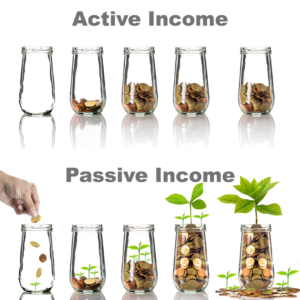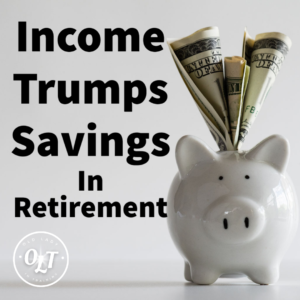
Forget the Nest Egg: How Passive Income is Redefining Retirement
Why Income in Retirement is More Important than Savings
A Brief Overview
- Income Continuity: Unlike savings that can run out, passive income sources provide a steady stream of income that can continue indefinitely, assuming the income sources remain viable.
- Inflation Hedge: Passive income, especially when derived from rental real estate or a business that can adjust its prices, can serve as a hedge against inflation. Your rental income or business revenue can increase with inflation, whereas the purchasing power of savings typically diminishes with inflation.
- Potential for Growth: Passive income sources such as an online business or investment in stocks have the potential for growth over time. This growth can often outpace the interest earned from savings.
- Tax Benefits: Depending on the jurisdiction and the nature of your passive income, there can be tax benefits. For example, income from investments like stocks and real estate can be taxed differently than regular income, which can make them more effective in the long term compared to savings.
- Diversification: Having multiple sources of passive income can offer financial stability. If one source of income faces a downturn, others can compensate. Savings, on the other hand, put all your eggs in one basket.
- Greater Returns: Passive income sources like rental real estate, dividend stocks, or a successful online business can potentially generate a higher rate of return than interest from savings accounts, particularly in today’s low-interest environment.
- Active Engagement: While savings typically sit in an account, passive income sources can keep retirees mentally engaged. Whether it’s managing rental properties or an online business, these activities can provide purpose and fulfillment during retirement years.
- Control: Unlike savings which are largely dependent on the interest rates set by banks or financial institutions, passive income streams often allow you more control over your potential returns, particularly in the case of businesses or investments where your decisions can directly influence the outcomes.
- Asset Appreciation: In addition to generating passive income, some sources like real estate or a business can increase in value over time. This provides an added layer of financial security that savings alone might not offer.
- Financial Legacy: Passive income sources such as real estate or a successful online business can also be passed on to future generations, potentially providing a source of income for your heirs.
A Case for Creating Passive Income
Income Continuity
Savings, no matter how substantial, is a finite resource. If you’re relying solely on savings during retirement, you’re essentially working with a countdown timer, a nest egg that diminishes with each withdrawal. Even a well-planned budget can face unpredictable expenses, and over time, it’s possible that your savings could eventually deplete. 
In contrast, passive income sources, if well managed, can provide a continual stream of revenue, akin to an ever-flowing spring. Examples of such income sources include rental income from real estate, dividends from investments, earnings from an online business, or royalties from a creative work. The key aspect of these income sources is that they have the potential to generate revenue regularly without the need for active, daily involvement.
Think of it like this – with savings, you’re eating into the capital each time you spend. It’s like consuming a loaf of bread slice by slice; eventually, the loaf will be gone. However, with passive income, it’s more like having a bread-making machine that produces a new loaf periodically. As long as the machine is well-maintained and the necessary ingredients are available, it will continue to churn out bread. This principle is what sets passive income apart and makes it a desirable component for a robust retirement plan.
This continuity of income can add a level of financial security and peace of mind during your retirement years, knowing that you have an ongoing income source that won’t run dry.
To Hedge Against Inflation
Inflation is a reality that everyone must contend with, and it poses a particularly substantial threat during the retirement years. Savings, while secure, do not grow on their own, and the purchasing power of your saved money decreases over time due to inflation. This essentially means that the $100,000 you have saved today will not have the same buying power 10, 20, or 30 years from now.
 On the other hand, certain types of passive income can act as a hedge against inflation. Let’s consider real estate as an example. If you own a rental property, you can generally increase the rent over time to keep pace with inflation. This means that your income from the property maintains its value even as the cost of living rises.
On the other hand, certain types of passive income can act as a hedge against inflation. Let’s consider real estate as an example. If you own a rental property, you can generally increase the rent over time to keep pace with inflation. This means that your income from the property maintains its value even as the cost of living rises.
Similarly, if you own an online business, you have the potential to adjust your prices in line with inflation. In this way, the revenue you earn retains its purchasing power, offering a layer of protection against inflation that static savings simply can’t provide.
Investments that pay dividends, such as stocks and mutual funds, also typically provide some level of inflation protection. As businesses raise prices to keep up with inflation, their profits and subsequently dividends often rise as well.
In essence, passive income sources that can adjust with the economic climate offer a powerful tool to preserve the value of your retirement income, helping to ensure that the money you earn today will continue to support your lifestyle in the future, despite the effects of inflation.
Potential for Growth
When you rely solely on savings for retirement, the amount you have is essentially fixed. Once you have saved a certain amount, that’s it – there’s no additional money coming in unless you continue working or receive other types of income. Moreover, if your savings are kept in low-interest accounts, their growth can be quite minimal over time.
However, passive income sources offer significant potential for growth, often far outpacing what traditional savings can provide. Let’s look at a few examples:
- Investments: If you’re investing in stocks, bonds, or mutual funds, your investments have the potential to grow significantly over time due to the power of compound interest. This means the interest you earn on your investments is reinvested, earning further interest, resulting in exponential growth over the long term.
- Online Business: If you have an online business, such as an e-commerce store, blog, or affiliate marketing site, you have numerous opportunities to expand your operations and increase your income. This could involve reaching new customers, adding new products or services, or optimizing your website for better conversions.
- Rental Properties: If you own rental properties, the income you receive can increase over time through rent increases. Additionally, as you pay down the mortgage on your property and eventually own it outright, your income from the property can increase significantly.
- Royalties: If you’ve written a book, created a popular online course, or developed a successful app, the royalties you earn can continue to grow as more people discover and purchase your product.
The bottom line is, unlike savings, passive income sources can grow and expand, improving your financial security in retirement and potentially allowing for a more comfortable and fulfilling lifestyle.
Tax Benefits
Savings accounts and similar deposit-based accounts often do not provide any tax advantages. The interest you earn is usually subject to income tax, which can eat into your retirement savings over time. However, various forms of passive income may offer significant tax advantages that can help to preserve and even enhance your retirement income. Here are some examples:

- Investment Income: Long-term capital gains, which are the profits from the sale of investments you’ve held for over a year, are taxed at a lower rate than ordinary income in many jurisdictions. This means that if you’re generating income through the sale of stocks or other investments, you could keep more of your earnings.
- Real Estate Income: Rental income can provide numerous tax benefits. For instance, you can often deduct expenses related to your rental property, such as maintenance costs, property management fees, and mortgage interest. In the United States, there’s even a depreciation deduction, allowing you to write off a portion of the cost of the property over time.
- Business Income: If you run an online business, you may be able to deduct business expenses, such as the cost of setting up and maintaining your website, advertising costs, and home office expenses. Additionally, you may be able to take advantage of specific tax structures that can minimize your overall tax liability.
- Retirement Account Distributions: If your passive income is generated within certain retirement accounts, such as a 401(k) or an IRA, you may have tax advantages when you start taking distributions. For instance, Roth IRAs in the United States allow for tax-free withdrawals in retirement, assuming certain conditions are met.
These are just a few examples of the potential tax benefits that can come from generating passive income, rather than relying solely on savings for retirement. As always, it’s important to consult with a tax professional to understand the tax implications of your specific situation.
Diversification: Financial Stability Through Multiple Passive Income Streams
Putting all your money into a savings account is similar to betting on a single horse in a race – it’s a riskier proposition. If the bank goes under, or if inflation rates exceed the interest you’re earning, your savings could be in jeopardy. However, diversifying your income by creating multiple sources of passive income can offer a greater level of financial stability, especially crucial during retirement years.

- Reducing Dependence on a Single Source: By creating multiple streams of passive income, you reduce your financial dependence on any one source. This can provide a safety net if one income stream dries up or declines.
- Compensating for Market Fluctuations: Various passive income sources are influenced by different market conditions. For instance, a downturn in the stock market may not affect your real estate rental income or the profits from your online business. This kind of diversification allows you to weather economic storms with greater ease.
- Potential for Greater Returns: Multiple income streams can potentially provide higher total returns than a single savings account. For example, income from an online business or real estate rentals could exceed the interest you would earn from keeping the same amount of money in a savings account.
- Flexibility and Control: Diversification also provides a level of control over your income sources. You can adjust your investments and strategies based on market conditions, personal interests, and financial goals. This level of flexibility is not often found with a basic savings account.
By generating passive income through multiple avenues, you can effectively spread your risk and create a more resilient financial portfolio for your retirement. This approach can help you achieve a level of financial stability that would be challenging to accomplish with savings alone.
Greater Returns: Maximizing Earnings with Passive Income
While savings accounts offer stability, their returns are often meager, especially in our current low-interest-rate environment. They can barely keep up with inflation, let alone grow your wealth. On the other hand, passive income sources such as rental real estate, dividend stocks, or a profitable online business can provide significantly higher returns, making them a more viable route to financial prosperity.
- Rental Real Estate: Properties typically appreciate in value over time, offering increased returns when sold. In addition, rental income can provide a steady cash flow that often exceeds the interest earned on a savings account. It’s a tangible asset that you control and has the potential to offer both passive income and capital appreciation.
- Dividend Stocks: Investing in dividend-yielding stocks can be a potent wealth-building tool. These stocks pay out a portion of their earnings to shareholders, providing a regular income stream. The advantage is twofold – not only do you get the dividends, but you also stand to gain if the stock price appreciates.
- Successful Online Business: An online business, like e-commerce or a blog with affiliate marketing, can provide significant income if done right. The internet has opened up countless opportunities for generating income, from selling products to offering services, and much more. Plus, the startup costs are often minimal compared to a traditional brick-and-mortar business.
 In an age where interest rates on savings accounts are minimal, these passive income avenues can offer more substantial returns and expedite your journey towards financial independence in retirement. It’s about making your money work harder for you, and passive income can do just that.
In an age where interest rates on savings accounts are minimal, these passive income avenues can offer more substantial returns and expedite your journey towards financial independence in retirement. It’s about making your money work harder for you, and passive income can do just that.
Active Engagement: Staying Mentally Vibrant with Passive Income
Savings typically sit in a bank account, barely seeing any action. However, generating and maintaining passive income can be a dynamic process that keeps retirees mentally engaged. This active involvement goes beyond mere financial benefits, contributing significantly to a retiree’s sense of purpose, fulfillment, and overall well-being during their golden years.
- Managing Rental Properties: Being a landlord, even a passive one, requires active decision-making. Choosing the right tenants, coordinating property maintenance, and making financial decisions can all stimulate mental activity. These tasks can become an engaging hobby that keeps your mind sharp, while also providing a steady stream of income.
- Running an Online Business: An online business demands constant learning and adaptation. Keeping up with market trends, learning new digital tools, and interacting with customers can be mentally stimulating. It can also provide a creative outlet, whether you’re designing new products, writing blog posts, or creating marketing strategies.
- Investing in Dividend Stocks: Making investment decisions requires research and an understanding of the market. Tracking your investments and understanding financial news can be intellectually stimulating and can also help you stay abreast of the wider world.

Retirement is not about retreating from the world, but rather about redefining your engagement with it. Passive income sources allow retirees to remain mentally active and engaged, which can lead to a more fulfilling and enjoyable retirement. The financial independence that comes with passive income is just the icing on the cake.
Control: Empowerment Through Passive Income
One key difference between savings and passive income sources lies in the level of control you can exercise over your financial returns. With savings, your returns are typically at the mercy of interest rates set by banks or financial institutions. In times of low-interest rates, your savings might even fail to keep up with inflation, essentially devaluing your money over time.
On the other hand, passive income streams often put you in the driver’s seat, allowing you to influence your potential returns significantly, particularly with businesses or investments. Here’s how:
- Online Businesses: Running an online business allows you to make strategic decisions that can directly affect your income. From deciding on the products or services to offer, setting the prices, to planning marketing strategies – each decision can boost your profitability and overall financial returns.
- Investments: Investments such as stocks, bonds, or real estate present an opportunity to exert more control over your financial growth. By carefully choosing your investments and managing your portfolio well, you can influence your returns significantly. Of course, all investments carry risk, but informed decision-making can help mitigate these risks and increase the likelihood of strong returns.
- Rental Properties: If you own rental properties, you can influence your returns by maintaining your property well, choosing reliable tenants, and setting competitive rental rates.
Thus, generating passive income can provide a sense of empowerment and control over your financial future that simply saving money cannot. By proactively managing your passive income sources, you can effectively strategize for higher returns, giving you a firmer grasp on your retirement income.
Asset Appreciation: Building Wealth Beyond Income
Asset appreciation is a significant advantage that certain types of passive income sources have over traditional savings. When you invest in assets like real estate or a business, not only do you generate ongoing passive income, but the value of your investment itself can also grow over time. This dual benefit of income generation and asset appreciation provides a strong foundation for financial security that simply cannot be matched by savings alone. Let’s dive a little deeper into this:
- Real Estate: Real estate is a classic example of an investment that can appreciate over time. When you buy a property and rent it out, you generate a steady stream of rental income. Simultaneously, the property itself often increases in value over the long term. This means that if you ever decide to sell the property, you could potentially make a significant profit on top of the rental income you’ve already earned.
- Online Businesses: If you start an online business that becomes successful, its value can increase substantially. This means that if you choose to sell the business in the future, it could command a high price. In the meantime, the business can provide you with regular income through its operations.
- Investments in Stocks or Bonds: While the primary purpose of investing in stocks or bonds is to generate income through dividends or interest, the value of these investments can also rise over time. This appreciation can increase your net worth and give you the option to sell at a profit if needed.
Asset appreciation, therefore, gives you the opportunity to build wealth and increase your financial security. It acts as a safety net, providing you with options and flexibility as you navigate your retirement years. So while savings are a useful tool for preserving wealth, investing in appreciating assets can be a powerful strategy for growing it.
Financial Legacy: Securing Your Family’s Future
Passive income isn’t just about ensuring your own financial security in retirement; it can also be a powerful tool for creating a lasting financial legacy for future generations. Investments in assets like real estate or an online business don’t just vanish when you’re gone. Instead, they can continue to generate income and provide financial support for your loved ones. This legacy aspect distinguishes passive income sources from savings, which can be depleted over time.
- Real Estate Legacy: Real estate is often considered a ‘legacy asset’ because it can be passed down from generation to generation. A well-selected and well-maintained property could provide rental income for your children, grandchildren, or even great-grandchildren. They could also choose to live in the property or sell it, potentially benefiting from any appreciation in its value.
- Business Legacy: An online business that you’ve built and grown can also form part of your financial legacy. With the right management in place, the business can continue to operate and generate income after your lifetime. Your heirs can continue to run the business, hire a management team, or sell the business, using the proceeds to support their financial goals.
- Investment Legacy: Investments in stocks, bonds, or other assets can also be passed down to your heirs. These investments can continue to generate income through dividends or interest payments, and their value may appreciate over time.
By establishing passive income streams, you’re not just securing your own future but also potentially the futures of those who come after you. It’s a way of providing for your family that can far outlast the span of a typical savings account and serves as another testament to the power of passive income.
Taking the Leap: Your Financial Future Begins Today
In conclusion, generating passive income isn’t just a strategy—it’s a mindset, a new approach to financial stability that can be truly transformational, particularly as you near retirement. The potential benefits we’ve explored—higher returns, an inflation hedge, active engagement, diversification, and leaving a lasting financial legacy—make it clear that passive income sources offer advantages that traditional savings simply can’t match.
However, these benefits aren’t automatic. They are the result of deliberate choices, sound strategies, and consistent action. No matter what stage of life you’re in, it’s never too late to start building your passive income portfolio. Whether you’re drawn to real estate, eager to start an online business, or keen to explore the world of dividend stocks, the key is to take the first step.
Remember, you’re not alone on this journey. There are resources, guides, and communities out there ready to help you navigate the world of passive income. Yes, there will be challenges, and yes, there may be setbacks. But don’t let that stop you from taking control of your financial future.
Your journey towards financial independence and a secure retirement starts today. So, don’t delay. Start researching, start planning, and most importantly, start acting. The future you dreams is within your reach, and it begins with the decision to create your passive income portfolio.
If you enjoyed this article, please take a moment to share it on social media